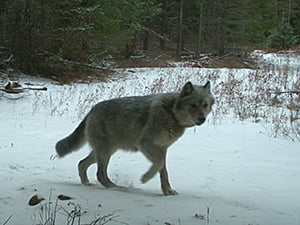
The California Department of Fish and Wildlife (CDFW) is reporting an unusually high number of canine distemper virus (CDV) cases in wildlife populations throughout the state. CDV can infect a wide range of domestic and wild carnivores, including some non-canids. Gray foxes, raccoons and skunks are the most commonly affected species.
Unvaccinated domestic dogs can potentially contract the disease through contact with food or water bowls that are “shared” with infected wild carnivores. Pet owners should be particularly vigilant in their efforts to keep their domestic animals from coming into contact with wildlife. CDV is not transmissible to humans.

“Keeping dogs up to date on vaccinations not only protects pets, it protects wildlife,” said CDFW Senior Wildlife Veterinarian Deana Clifford. “Wild animals can spread distemper to domestic dogs, but unvaccinated domestic dogs can also spread the disease to wild animals.”
Dr. Clifford noted that distemper is the most common disease CDFW finds as the cause of death in California’s carnivores. Large outbreaks of distemper may temporarily reduce some local carnivore populations, thus wildlife biologists and veterinarians monitor reports of sick animals and confirm disease cases when possible to track potential impacts.
Transmission of CDV typically occurs similar to the common cold, via inhalation of infected respiratory droplets or direct contact with saliva, nasal discharge and tears. Occasionally other body fluids (feces and urine) contain the virus. Environmental transmission of canine distemper is rare because the virus does not survive long in the environment.
For this reason, CDV presents more of a problem for dense wild carnivore populations as close contact between animals is necessary to spread the disease. While distemper may occur at any time of year, CDV is more common in adult animals during the winter and is thought to be more common in juvenile animals in the spring and summer.

Distemper can cause respiratory, neurologic and gastrointestinal illness. Clinical signs may vary depending on the strain of the virus, the environment, the host species and the age of the infected animal. Signs include (but are not limited to) depression, fever, labored breathing, diarrhea, anorexia, incoordination, moving in small circles, yellow to clear discharge from the nose and eyes, and crusting on the nose, eyes, mouth or footpads.
There is no treatment for sick animals except supportive care. Infected animals may or may not survive the illness. Animals with the virus may not show clinical signs but can still spread the virus for up to 90 days.
In addition to removing food and other attractants, CDFW urges the public to keep a safe distance from sick or injured wild animals, as animals that are ill or feel threatened may act aggressively. Please report the sick animal’s behavior and location to the closest CDFW office and/or to a local animal control agency, as soon as possible.
Any wildlife encounter that is an emergency should be reported to 9-1-1. For non-urgent questions concerning wildlife, please contact your local CDFW Regional Office or your local animal control service. Additional information about living with wildlife can be found on CDFW’s website.
If you are bitten or scratched by a wild animal, please wash the wound vigorously with soap and water and consult a physician and/or contact your County Public Health Department. Neurologic signs of CDV may not be distinguishable from rabies virus infection, which is a public health risk.
Do not handle carcasses of wild animals with bare hands. CDFW’s has protocol for safe handling and disposal of carcasses on its website.

